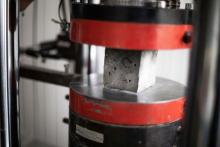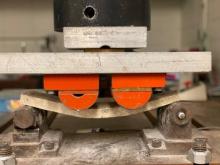Lithuanian scientists at the Kaunas University of Technology (KTU) are working on methods to produce concrete using industrial waste - fly ash.
A report by KTU says the product is as strong as traditional concrete and is more resilient to acid and more stable in exposure to extreme heat and cold.
Vytautas Bocullo, researcher at KTU’s faculty of civil engineering and architecture, says: “At first, the idea that concrete can be produced without using cement seemed radical. Now, after several years of intensive work we succeeded to develop alkali activated concrete, which compressive strength is 55 MPa (the same as in usual concrete). Instead of Portland cement we are using alkali activated industrial waste products – fly ash, biofuel bottom ash, AlF3 production waste – silicagel etc.”
Bocullo insists the main advantage of this type of binder is that in its production a great amount of industrial waste containing silicon and aluminum compounds can be used.
The report says: “Treated with special alkaline solution these materials start melting and binding similarly to traditional cement.”
The final product, depending on the composition, can be either geopolymer or alkali-activated material. Alkali activated concrete is expected to be more resilient to the effects of fire and acid. In addition, this concrete is protecting armature against corrosion due to its high pH.
Bocullo believes alkali activated concrete can be used instead of traditional concrete in many fields and is becoming an alternative to traditional concrete.
According to the report: "By properly preparing raw materials and the activating solution, such concrete is solidifying in usual (+200) temperature. However, in order to cost-efficiently produce this type of concrete, it is recommended to use local materials."
Bocullo reveals: “We are trying to use waste materials from local industry, such as aluminum fluoride production waste – silica gel and biofuel ash. The preparation of the substance depends on the material itself. For example, fly ash of coal can be used instantly, but the biofuel ash need to be grinded up to the fineness of the cement. In order to improve the qualities of the final product, several substances can be mixed, but before that their chemical composition and additives need to be investigated for their impact on the environment and on the compressive strength of the concrete.”
Additionally, the research groups working in the KTU Faculty of Civil Engineering and Architecture are developing other types of concrete mixtures, such as ultra-high performance concrete and self-renewing concrete.





